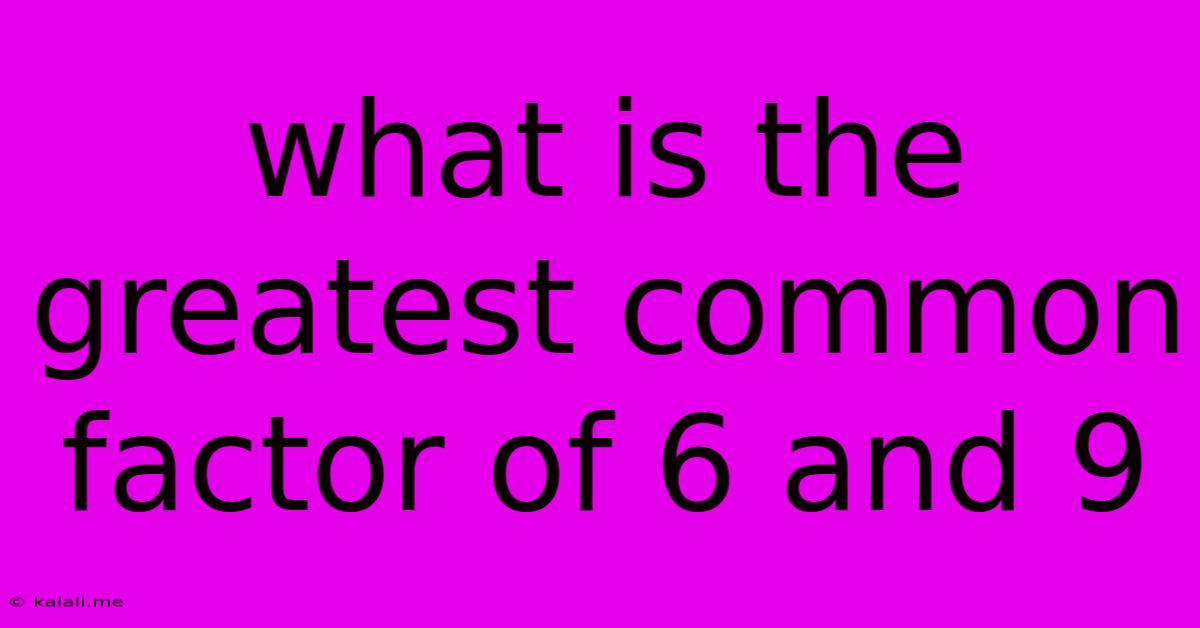What Is The Greatest Common Factor Of 6 And 9
Kalali
May 10, 2025 · 3 min read

Table of Contents
What is the Greatest Common Factor of 6 and 9? A Step-by-Step Guide
Finding the greatest common factor (GCF) of two numbers might seem like a simple math problem, but understanding the concept and the various methods to solve it is crucial for various mathematical applications. This article will clearly explain how to find the GCF of 6 and 9, exploring different approaches and highlighting their practical uses. We'll cover prime factorization, listing factors, and using the Euclidean algorithm.
What is a Greatest Common Factor (GCF)?
The greatest common factor (GCF), also known as the greatest common divisor (GCD), is the largest positive integer that divides each of the integers without leaving a remainder. In simpler terms, it's the biggest number that can be divided evenly into both numbers. Understanding GCF is fundamental in simplifying fractions, solving algebraic equations, and various other mathematical problems.
Method 1: Prime Factorization
This is arguably the most straightforward method for finding the GCF, especially when dealing with larger numbers. Let's break down 6 and 9 into their prime factors:
- 6: The prime factorization of 6 is 2 x 3.
- 9: The prime factorization of 9 is 3 x 3.
Now, identify the common prime factors. Both 6 and 9 share a prime factor of 3. Therefore, the greatest common factor of 6 and 9 is 3.
Method 2: Listing Factors
This method is ideal for smaller numbers. Let's list all the factors of 6 and 9:
- Factors of 6: 1, 2, 3, 6
- Factors of 9: 1, 3, 9
By comparing the lists, we can see that the common factors are 1 and 3. The largest common factor is 3. This confirms the result we obtained using prime factorization.
Method 3: Euclidean Algorithm (for larger numbers)
The Euclidean algorithm is a more efficient method for finding the GCF of larger numbers. While not strictly necessary for 6 and 9, understanding it is valuable for more complex scenarios. This method involves repeatedly applying the division algorithm until the remainder is 0. The last non-zero remainder is the GCF.
It's less intuitive for small numbers like 6 and 9, but its efficiency becomes apparent with larger numbers. For this example, we wouldn't typically use the Euclidean Algorithm.
Practical Applications of GCF
Understanding and applying the GCF has numerous practical uses:
- Simplifying Fractions: To simplify a fraction, you divide both the numerator and denominator by their GCF. For example, the fraction 6/9 can be simplified to 2/3 by dividing both by their GCF, which is 3.
- Solving Algebraic Equations: GCF is used to factor expressions, simplifying them and making them easier to solve.
- Real-world problem-solving: Imagine you're dividing items into equal groups. Finding the GCF helps determine the largest group size possible.
Conclusion
The greatest common factor of 6 and 9 is 3. We've explored three different methods to arrive at this answer – prime factorization, listing factors, and (briefly) the Euclidean algorithm. Understanding these methods provides a strong foundation for tackling more complex mathematical problems involving GCF and related concepts. Remember to choose the method that best suits the numbers you're working with. For smaller numbers, listing factors is often the quickest approach, while prime factorization is generally more efficient for larger numbers. The Euclidean algorithm is best suited for very large numbers where the other methods become computationally expensive.
Latest Posts
Latest Posts
-
How Long Is A China Man Joke
Jul 05, 2025
-
What Episode Does Ichigo Get His Powers Back
Jul 05, 2025
-
Pokemon Mystery Dungeon Red Rescue Team Codes
Jul 05, 2025
-
How Much Is 25 20 Dollar Bills
Jul 05, 2025
-
How Many Apples In 3 Lb Bag
Jul 05, 2025
Related Post
Thank you for visiting our website which covers about What Is The Greatest Common Factor Of 6 And 9 . We hope the information provided has been useful to you. Feel free to contact us if you have any questions or need further assistance. See you next time and don't miss to bookmark.